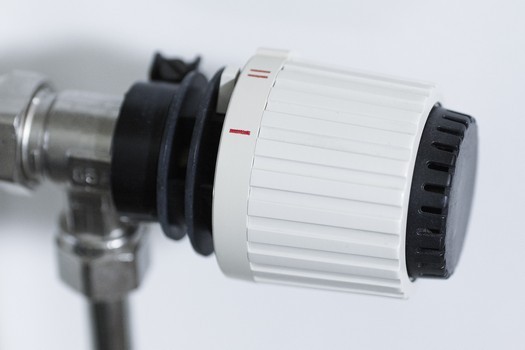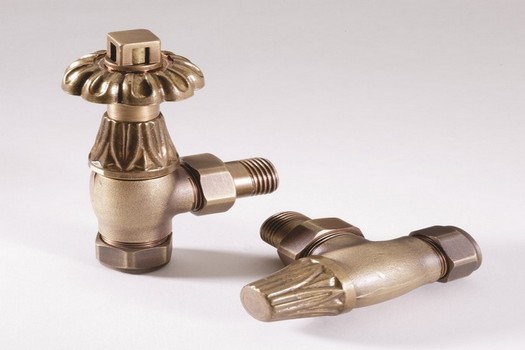
Radiator valves are essential to any heating system, as they connect the radiator or Heated Towel Rail to the central heating pipes. They are necessary for ensuring your home is kept at a comfortable temperature throughout the year and connect your heating system to the radiator (with some having the option to be switched on and off). Radiator valves come in manual and thermostatic varieties, each offering advantages. With the right combination of radiator valves, you can ensure your home is heated efficiently while controlling costs. By understanding how radiator valves work and what types are available, you can ensure your heating system runs smoothly and safely all year round.

What types of radiator valves can I Buy?
Showers to You sell various designs of radiator valves. These include the following designs:
Angled Radiator Valves connect the radiator to the heating pipes at an angle (around 90°).
Straight Radiator Valves ensures the water flows in a straight line and usually connects the radiator and pipes from the floor in a horizontal position.
Corner Radiator Valves are similar to Angled Radiator Valves but do not protrude into the bathroom as much.
Manual Radiator Valves can manually control the temperature of the radiator. Simple turn on and off at your own leisure.
Thermostatic Radiator Valves maintain a constant temperature within the room.
How much does a radiator valve cost?
he cost of a radiator valve can vary based on the type of valve, the size and brand. Generally speaking, simple manual valves start at around £10-£20 each. However, thermostatic valves tend to be more expensive, ranging from £30-£80 per valve, depending on size and features. If you require professional installation, there may also be an additional fee for labour costs.
How do I install a radiator valve?
Installing a radiator valve is not complicated, but qualified professionals should always do it to ensure that any warranty remains intact and the job is done safely. Generally speaking, you must turn off the water supply, unscrew the existing valve and replace it with a new one. The exact process will vary depending on your system type, so it is best to consult an engineer if you are still determining.
Why not check out our in-depth guide on How to Install a Radiator?
How do I know which type of radiator valve to buy?
Choosing the suitable radiator valves for your system depends on your individual needs (check out our Reina Radiator Valve Collection). Manual valves are generally cheaper but more difficult to control as they require manual adjustments when temperatures change. Thermostatic valves are more expensive but offer automated temperature control and can help save energy costs in the long run due to their efficient use. If you need more clarification, consult a qualified heating engineer who can advise you on the best option for your system.
What is a thermostatic radiator valve (TRV)?
A thermostatic radiator valve, or TRV, is an automated temperature control system that helps to regulate temperatures in individual rooms. They work by sensing room temperature changes and adjusting hot water flow through the radiator accordingly. This means you don't have to adjust valves when temperatures change manually.
How do I know if my current radiator valves work properly?
If your current valves don't control temperatures properly or allow the heated water to pass through to the radiator/ heated towel rail, it could indicate that the valves are not working as they should. Check to make sure that the valves open and close correctly when adjusting the temperature settings, and if you're still having problems, then it may be worth consulting a qualified engineer.
What other types of valves are available for radiators?
Besides manual and thermostatic radiator valves, zone valves and motorised valves are also available. Zone valves help control several radiators connected in series. In contrast, motorised valves can automatically open/close radiators based on settings programmed into a central thermostat.
What is the difference between radiator and lockshield valves?
A radiator valve is used to control the temperature of an individual room. In contrast, a lockshield valve is used to adjust the overall flow of water through the entire system. Qualified professionals must carefully install both valves to ensure they operate safely and effectively.
Are there any safety considerations to consider when using radiator valves?
There are several safety considerations to consider when using any radiator valve. Always ensure you turn off the water supply before attempting any maintenance on your valves, and always consult a qualified engineer if you need clarification. It is also essential to check for corrosion or damage regularly, as this could indicate that the valve needs replacing sooner rather than later. Additionally, thermostatic valves should be kept away from heat sources, such as radiators or windows, to ensure accurate temperature readings.
How do I know which type of radiator valve will be best for my home?
The type of radiator valve that will work best for you will depend on factors such as the size and layout of your home and how much control you need over temperatures in individual rooms. For instance, manual valves are generally the most cost-effective option. Still, they may need to provide the level of accuracy that more advanced valves, such as motorised or thermostatic models. These valves continue to heat the room as long as the heating system is turned on, which can be counterproductive if a window is opened to cool the room. Thermostatic designs are more expensive, but they regulate the temperature better because they don't use unnecessary heating. Ultimately, assessing your needs is important to decide which type of valve best suits your home.
What are some tips for caring for my radiator valve?
When caring for your radiator valve, it's essential to make sure that you clean it regularly, check for any signs of corrosion and make sure all connections are secure and tight. Additionally, suppose you have a thermostatic or motorised valve. In that case, regular maintenance should be carried out to ensure optimum performance.
What are some common problems with radiator valves?
Common issues with radiator valves include leaks from loose connections, air bubbles leading to reduced heat output, and faulty thermostatic settings. It is also essential to look for corrosion or rust, which could cause the valve to stick or seize up altogether. Suppose you're experiencing any of these issues. In that case, it is recommended that you consult a qualified engineer to assess and fix the problem.
What are the advantages and disadvantages of using radiator valves?
The main advantages of radiator valves include improved efficiency, more precise control over temperature settings and extended life span. On the other hand, there are potential drawbacks, such as additional installation costs, possible leaks from loose connections and regular maintenance required for motorised or thermostatic models. Ultimately, assessing your needs is important to decide which type of valve will work best for you.
Are there any types of radiators that don't use valves?
Yes, there are certain types of radiators which are designed to operate without the need for a valve. These include Electric Radiators (see Kartell Electric Towel Rails) and infrared designs, which use electricity rather than water to generate heat, as well as panel radiators which are sealed units with no moving parts. However, it is important to note that these radiators can't be used with traditional central heating systems as they require a dedicated power source.
_19_05_2023.jpg)
What should I do if my radiator valve won't turn off?
If your radiator valve won't turn off, the first step should always be to ensure that all connections are correctly tightened and no parts are left loose. If this doesn't fix the issue, you should check for any signs of corrosion or damage that could prevent it from closing properly. Additionally, check that the thermostat is set correctly, as this can often be the source of common problems. Suppose any of these don't fix the issue. In that case, it is best to consult a qualified engineer for professional help.
What should I do if my radiator valve is leaking?
If your radiator valve leaks, it can be very dangerous as it could cause water damage or even electrocution depending on where the leak is located. The first step should be to switch off your central heating system and check for any loose connections which may need tightening. You may also want to check for signs of corrosion or damage which could be the source of the leak, as these need to be replaced before the system can be used again. If none of these solutions works, it is best to consult a qualified engineer to get professional help.
In summary, radiator valves are essential to many central heating systems as they allow users to control the temperature and flow of hot water around their homes. As such, it is important to understand the different types of valves available and how to maintain them correctly to ensure your system remains safe and efficient for years. Ultimately, with knowledge and regular maintenance, you should be able to get the most out of your radiator valve for many years.
Why should I buy a Radiator Valve from ShowerstoYou?
ShowerstoYou have supplied various Radiators, Heated Towel Rails and Radiator valves for over 40 years and have a knowledgeable team on hand. Our collection of radiator valves is from leading suppliers that suit every requirement, budget and personal taste at the best online prices. Get in touch today via email (info@showerstoyou.co.uk), telephone (01472 242159) or through our online contact form.
